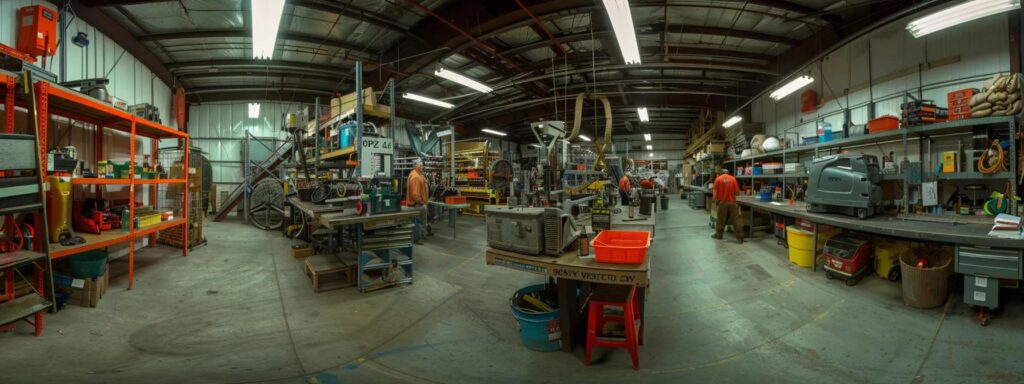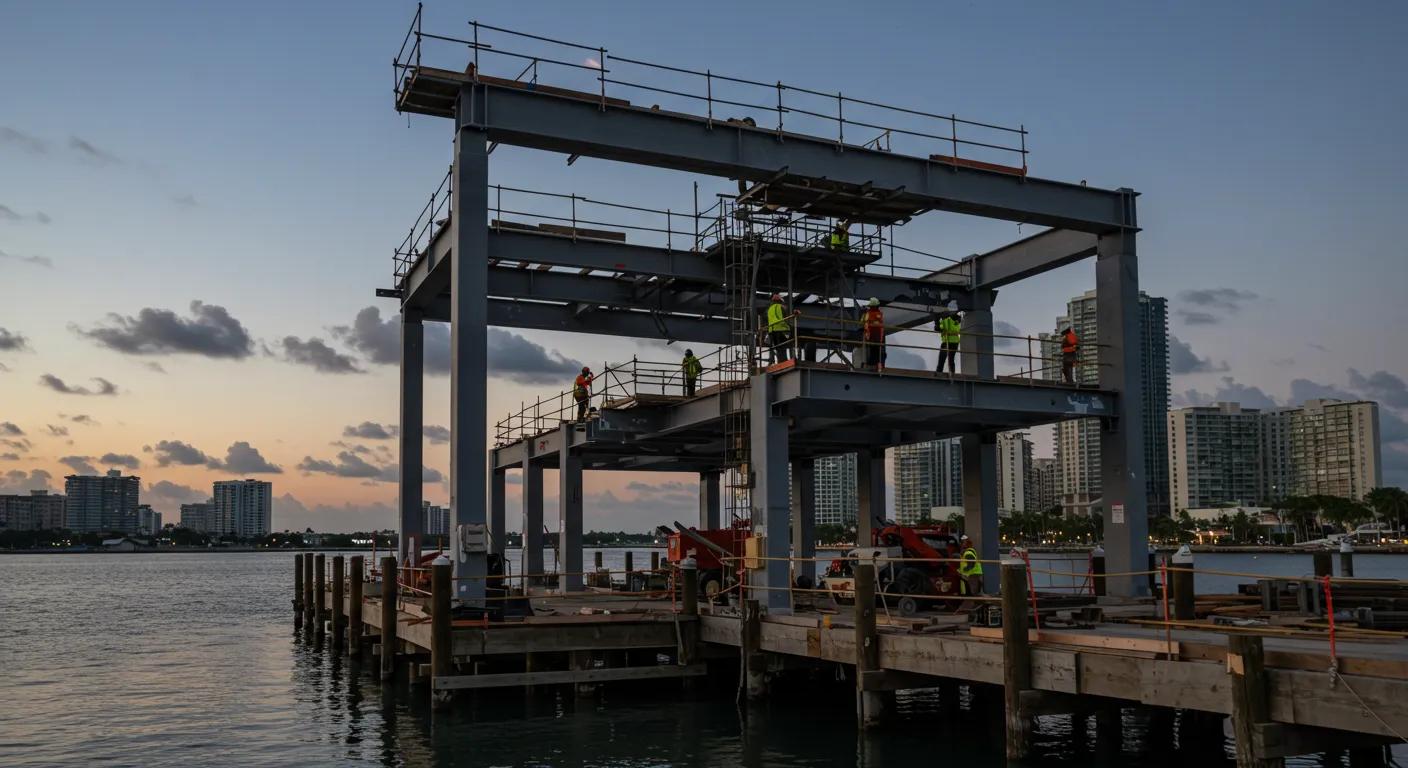What to Include in Your Dock Inspection Checklist
Ensuring the structural integrity and overall safety of your dock is essential for providing a safe environment for loading and unloading materials while protecting vital dock equipment such as forklifts, pallet racking, and dock levelers. Regular inspections help prevent accidents, extend the life of your structures, and ensure regulatory compliance, reducing downtime and repair costs. Whether you manage a commercial loading dock or a personal transport facility, this comprehensive checklist guides you through evaluating every dock component. The following guide covers structural integrity, safety equipment, electrical systems, environmental impacts, and compliance issues to help you maintain high dock safety and efficiency while protecting your investment.
With decades of craftsmanship and all American expertise at work, each step in this checklist has been developed with material durability, efficiency, and safety in mind. As you work through each section, you will find specific tasks, recommended maintenance frequencies, and common issues identified in routine inspections. This method minimizes operational hazards and ensures that your loading dock remains productive for both vehicles and pedestrians. Let’s begin with a detailed examination of the dock structure and its components.
Evaluate the Structural Integrity of Your Dock and Components
Assess the structural integrity of your dock by examining all components—from the overall frame and support beams to smaller details like exposed nails and splintered wood. Every part contributes to the dock’s ability to support heavy loads including vehicles and forklifts.
Inspect the Dock Frame and Support Beams for Damage or Wear
Check the dock frame and support beams for cracks, bends, or rust. Early identification of concrete spalling or weather-damaged wood can prevent larger safety issues. If small cracks or signs of stress appear, repair or reinforce the component immediately to avoid future accidents.
Assess the Condition of Decking Materials for Safety and Durability
Examine decking materials—whether concrete, wood, or composite—for uneven surfaces, cracks, or delamination. These issues can create tripping hazards and lead to inefficient load distribution. A quality deck is essential for pedestrian safety and overall structural performance.
Check for Any Signs of Rot or Corrosion on Metal Components
Inspect metal parts using a flashlight in low light for rust or pitting. Fasteners and support structures should be checked frequently since humidity, saltwater, and temperature shifts can accelerate corrosion. Protective coatings or timely replacements can help maintain safe load-bearing capacity.
Examine the Pilings for Stability and Secure Anchoring
Ensure that the pilings anchoring your dock to the seabed or riverbed are secure and stable. Look for cracks or signs of settlement, as even minor shifts can affect alignment and load distribution. Use appropriate tools to measure any movement and review past records to spot emerging trends.
Look for Exposed Nails or Splintered Wood That May Pose Hazards
Inspect for small details such as exposed nails or splintered wood that can injure staff or damage equipment. Secure or replace any rusted nails and repair damaged wood, as these minor issues can signal broader material degradation.
Review the Overall Alignment of the Dock With Shoreline Features
A well-aligned dock avoids uneven stress distribution and premature deterioration. Ensure the dock aligns with the water’s edge to optimize drainage and reduce erosion. Proper alignment also helps detect if weather events or sediment buildup have shifted the dock’s position.
Assess Safety Equipment and Maintenance Tools for Your Dock

Safety equipment and maintenance tools are critical for protecting workers and minimizing liability risks. This section covers inventory checks, functional tests, and regular updates for life-saving and emergency devices.
Confirm the Availability of Life Jackets and Flotation Devices
Ensure life jackets and flotation devices are readily available, stored in clean, well-marked locations, and in serviceable condition. Regularly inspect these items for wear, proper inflation, and secure fastenings, and provide clear instructions for emergency use.
Check the Functionality of Fire Extinguishers and Emergency Signals
Locate all fire extinguishers on the dock and verify that they are fully charged, accessible, and within their inspection dates. Test emergency signals such as alarms and sirens to ensure proper operation, following regulatory testing and documentation requirements.
Ensure That First Aid Kits Are Fully Stocked and Accessible
Check that first aid kits are sufficiently stocked with bandages, antiseptics, and essential supplies. Place kits in high-risk areas like near heavy equipment or dock entry points, and review them periodically to replace expired items and adjust supplies as needed.
Inspect Safety Lines and Ropes for Signs of Wear and Tear
Visually examine safety lines and ropes for fraying, rips, or excessive wear that could impair their function. Replace any items showing significant degradation to ensure constant protection during heavy cargo handling or equipment operations.
Maintain a Record of Maintenance Tools for Easy Accessibility
Keep a standardized log of all maintenance tools—from hammers and drills to specialized equipment like hydraulic jacks. Regularly update this inventory to streamline repairs during routine checks and emergencies, thereby reducing downtime.
Verify That All Equipment Meets Current Safety Standards
Regularly cross-check all safety equipment and maintenance tools with current OSHA standards and local safety guidelines. Periodic audits and certification checks help protect your staff and avoid potential penalties.
Inspect Electrical and Lighting Systems for Proper Functionality
The proper functioning of electrical and lighting systems is essential for safety, especially during low-light conditions. Regular inspections of outlets, wiring, and backup power sources ensure that hazards are quickly identified and mitigated.
Assess Electrical Outlets for Ground Fault Protection
Verify that dock electrical outlets are fitted with ground fault circuit interrupters (GFCIs) and are in good working order. Preventative testing and prompt replacement of worn components can prevent electrical shocks and protect sensitive dock control systems.
Check Lighting Fixtures for Damage or Burned-Out Bulbs
Inspect all lighting fixtures for damage or missing bulbs, and replace any burned-out bulbs promptly. Both primary lighting (for walkways and work areas) and accent lighting (highlighting potential hazards) are crucial to prevent trips, falls, and accidents.
Validate Wiring Connections for Any Signs of Deterioration
Examine wiring for corrosion, fraying, or deteriorating insulation using a multimeter for continuity tests. Secure and intact connections are critical to prevent short circuits and fire hazards.
Test Dock Lights for Adequate Illumination on Walkways
Ensure that all dock walkways and work areas receive adequate illumination. Test each light for brightness and proper alignment to guarantee effective coverage and safe navigation for pedestrians and heavy machinery.
Ensure That Electrical Systems Comply With Local Regulations
Review all electrical installations to ensure compliance with local codes and regulations. This process should include checking permits, past inspection reports, and any updates to safety guidelines to avoid fines and legal issues.
Review Backup Power Sources for Emergencies
Regularly inspect backup power systems, such as generators or battery backups, to confirm they are fully charged and properly connected. A reliable backup is essential for keeping safety systems like lighting and alarms operational during outages.
Evaluate Water Quality and Environmental Impact Around the Dock

Monitoring water quality and environmental conditions around your dock protects marine life and helps maintain the dock’s structural integrity. Key areas include water clarity, sediment buildup, and the presence of invasive species.
Test Water Clarity and Pollution Levels in the Vicinity
Regular water tests can reveal clarity issues or pollution from runoff, spills, or algae growth. Using professional testing kits and collaborating with environmental agencies ensures timely remedial measures to protect both the dock and the ecosystem.
Monitor for Invasive Species Affecting Local Ecosystems
Conduct regular surveys to identify invasive species that may damage wooden structures or clog drainage systems. Early detection and control of such species help preserve dock stability and the surrounding habitat.
Check for Sediment Build-Up That May Affect Dock Stability
Inspect for sediment accumulation that can alter water flow and pressure on pilings and foundations. Periodic sediment removal or drainage improvements can prevent instability and long-term structural damage.
Assess Water Flow Patterns and Their Impact on the Dock
Monitor water flow around your dock to detect potential erosion, washouts, or debris buildup. Consistent water flow patterns support effective drainage and structural integrity.
Consider Proximity to Fuel Sources and Their Environmental Risks
Evaluate the environmental risks posed by nearby fuel stations, shipping lanes, or industrial facilities. Early detection of chemical spills or fuel leaks is critical for safeguarding the dock and ensuring compliance with local environmental regulations.
Review Local Wildlife Habitats and Their Behaviors
Observe local wildlife activity to understand its potential impact on your dock. Frequent animal presence may accelerate material wear or interfere with safety systems, so consider preventive measures such as deterrents if needed.
Verify Compliance With Local Regulations and Guidelines
Adhering to local, state, and federal regulations is essential for dock safety. Regular audits help ensure that your dock meets all permit, zoning, and noise ordinances, reducing legal risks.
Research Local Dock Installation and Maintenance Regulations
Stay informed about local guidelines governing dock construction and maintenance, including material standards, load capacities, and periodic maintenance requirements. This knowledge is crucial for making compliant repairs and upgrades.
Confirm Required Permits and Their Expiration Dates
Keep current records of all necessary permits, noting expiration dates and any conditions attached. Liaise with the relevant agencies to renew permits before they lapse, thereby avoiding fines and operational disruptions.
Audit Any Previous Inspections for Compliance Issues
Review past inspection records to identify and resolve recurring compliance challenges. Documenting the implementation of recommendations supports continuous improvement and regulatory adherence.
Check Zoning Laws Related to Dock Placement and Usage
Ensure that your dock is located in an area designated for its intended use, whether commercial or recreational. Compliance with zoning regulations not only promotes safety but also helps prevent legal disputes over property boundaries.
Review Noise Ordinances Concerning Dock Operations
Examine local noise ordinances to ensure dock operations remain within acceptable levels, especially near residential or sensitive areas. Maintaining proper equipment condition and operational limits helps avoid fines and complaints.
Understand Property Lines and Shared Waterway Rules
Clarify property boundaries and shared waterway rules with neighboring users. Clear agreements and accurate property information aid in planning maintenance and avoiding legal conflicts.
Plan for Seasonal Changes and Routine Dock Maintenance
Seasonal variations such as winter freezes and summer heat require tailored maintenance strategies to preserve dock safety and functionality.
Schedule Regular Inspections to Adapt to Seasonal Changes
Plan inspections according to seasonal challenges. In winter, check for ice damage and water ingress; in summer, focus on humidity and sun exposure effects on materials. Documenting seasonal trends helps prioritize maintenance tasks.
Prepare for Winterization and Summer Readiness Tasks
Develop a checklist that includes winter tasks like insulating pipes and applying anti-freeze coatings, and summer tasks such as ensuring proper ventilation and clearing debris. This proactive approach minimizes weather-related damage.
Assess Wear and Tear From Seasonal Weather Effects
Regularly monitor the effects of temperature and moisture changes on both structural elements and safety equipment. Photographic records and measurements can help track deterioration and prompt timely repairs.
Review Any Necessary Repairs Before Peak Usage Seasons
Before periods of high dock activity, inspect and complete any critical repairs. Address both cosmetic issues and major structural reinforcements to prevent costly interruptions and ensure reliable operation.
Create a Maintenance Calendar to Track Important Activities
Maintain a detailed calendar to record inspection dates, repair works, and maintenance tasks. Digital apps can assist with reminders and historical tracking to optimize future maintenance efforts.
Plan for Dock Cleaning and Debris Removal Regularly
Regular cleaning removes algae, debris, and other material buildup that may pose slip hazards or contribute to corrosion. A clean dock not only improves safety but also eases the detection of early damage signs.
Frequently Asked Questions
Q: How often should I inspect the structural components of my dock? A: A comprehensive structural inspection every six months is recommended, with additional spot checks after severe weather events to catch early signs of wear or corrosion.
Q: What are some common signs of wear on dock decking materials? A: Look for uneven surfaces, visible cracks, splintered wood, or delamination in composite materials. Early detection allows for timely repairs to ensure safe load distribution.
Q: How do I ensure that safety equipment meets current regulatory standards? A: Regularly compare manufacturer specifications with local safety guidelines from OSHA and other authorities. Routine inspections, accurate documentation, and scheduled maintenance help maintain compliance.
Q: What steps can I take to prepare my dock for seasonal weather changes? A: Develop a seasonal maintenance plan that includes winterization tasks (like insulation and anti-freeze applications) and summer readiness measures (such as clearing debris and checking for heat-induced wear). A maintenance calendar can help manage these tasks efficiently.
Q: Why is it important to test electrical outlets and lighting systems on the dock? A: Proper testing ensures that outlets have ground fault protection and that lighting provides adequate illumination. Faulty outlets or poor lighting can lead to accidents and downtime during crucial operations.
Q: How do environmental factors affect dock stability? A: Factors like water quality, sediment buildup, and invasive species can undermine the dock’s foundation and structural integrity. Regular monitoring allows for corrective actions that maintain a safe and stable environment.
Q: What role does a maintenance log play in dock inspections? A: A maintenance log tracks inspection dates, repairs, and recurring issues, helping to identify trends and ensure proactive maintenance. This documentation is vital for accountability and optimizing future inspections.
Final Thoughts
Regular dock inspections are key to ensuring operational safety, regulatory compliance, and the long-term durability of your structures and equipment. By following this checklist, you address structural integrity, safety equipment functionality, environmental factors, and seasonal maintenance proactively. Each element reinforces the overall safety and productivity of the dock, protecting your assets and fostering a culture of continuous improvement.




